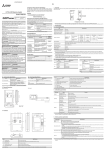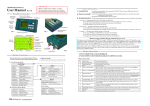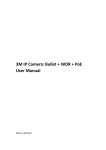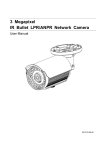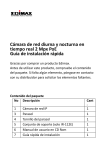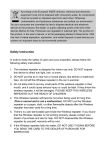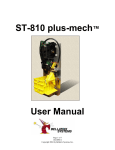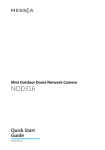Download 3MP_IP_Vandal Dome Network Camera
Transcript
3MP_IP_Vandal Dome Network Camera User Manual - Chapter I CONTENTS - Introduction .................................................................................................... 3 1.1 Highlights of your new Network IP Camera .......................................................... 3 1.2 Safety Instructions ............................................................................................... 5 1.3 Packaging Contents .............................................................................................. 6 1.4 Familiar with your new Network IP Camera.......................................................... 7 1.5 Installation of the Network IP Camera................................................................ 10 Chapter II Using Network IP Camera by Web Interface ................................................. 13 2.1 Locate the IP address of Network IP Camera ............................................................. 13 2.2 Connect to IP Camera’s Web User Interface and Install ActiveX Plugin ...................... 15 2.3 Viewing Live Video .................................................................................................... 18 2.4 Client Settings ........................................................................................................... 21 Chapter III Advanced Configuration ................................................................................... 23 3-1 System ...................................................................................................................... 24 3-2 Security..................................................................................................................... 26 3-3 Network.................................................................................................................... 28 3-4 IP Filter ..................................................................................................................... 28 3-5 Video ........................................................................................................................ 35 3-5-1 Image Setting ..................................................................................................... 36 3-5-2 Video Setting ..................................................................................................... 38 3-5-3 Overlay Setting .................................................................................................. 40 3-6 Audio ........................................................................................................................ 42 3-7 Motion...................................................................................................................... 43 3-8 RS-485 ...................................................................................................................... 45 3-9 Event ........................................................................................................................ 47 1 3-9-1 Settings .............................................................................................................. 48 3-9-2 Media ................................................................................................................ 50 3-9-3 Event Server....................................................................................................... 51 3-10 Recording to SD Card .............................................................................................. 55 3-11 Log .......................................................................................................................... 56 3-12 Device Info .............................................................................................................. 57 3-13 Maintenance ........................................................................................................... 58 3-14 Language ................................................................................................................ 60 Chapter IV Troubleshooting ............................................................................................ 61 2 Chapter I Introduction 1.1 Highlights of your new Network IP Camera This Vandal Dome network camera provides super image quality and remarkable bandwidth efficiency. The camera supports H.264 High Profile, Main Profile, and Baseline Profile video stream compression technology. With H.264 higher video compression performance, the file size of transmitted video stream is extremely reduced so as to optimize the network bandwidth efficiency. This Vandal Dome network camera has up to 15M IR illumination distance. It offers true day/night function to maintain clear images 24 hours a day. The build-in Micro SD card slots provides a convenient and portable storage option for local storage of event and schedule recordings in case of network disconnection. This Vandal Dome network camera has 3-AXIS design. User can adjust image flat horizontal surface no matter what ceiling point of view. This Vandal Dome network camera is equipped with PoE (Power over Ethernet) IEEE802.3af, allowing power and signals to be transmitted over the same cable, thus eliminating the need to install a separate power source for each camera. The digital motion detector feature transmits an alarm signal when moving subjects enter the scene. Together with 64-CH central software management software for live view and recording. 3 Key feature of this network IP camera include: IR Illumination Distance over 15 Meters. Mechanical IR-Cut Filter Removable. Up to QXGA Resolution at 20 FPS. H.264 HP, MP, BP/MPEG4 SP /MJPEG Multiple Stream Output for Simultaneously Live Monitoring and High Resolution Recording. Built-in Micro SD Memory Card Slot for Local Storage. Event Management by Motion Detection, Alarm Trigger. Support Two Way Audio. Support Mobile Phone Remote Monitoring. Power over Ethernet. WDR support. ONVIF Compliant. 4 Safety Instructions Please follow the safety instructions listed below when you’re using this Network IP Camera, or you would harm this camera and / or yourself! Also, the warranty will become void if you disobey these safety instructions. This Network IP Camera is sophisticated electronic device; do not drop it from high places. Do not place this IP Camera at hot / humid places, and avoid direct sunlight. This IP Camera is not a toy; keep it out from the reach of children. Do not insert any accessories of this IP Camera into your body. Make sure lens set is secured when you’re using this IP Camera, lens set may fall down if it’s not properly secured, and cause damage to human and itself. If you want to use this IP Camera at any place that may be spilled by water or dirt, a secure and water-proof camera housing is required. Do not pull any cord that is connected to this IP Camera by force. IP Camera will become hot after long time of use. Refrain from touch IP Camera with hand, or cover this IP camera with paper or cloth. Never connect powered cable to IP Camera’s DI/DO contacts. If the IP Camera falls into water when powered, do not attempt to retrieve it back by yourself! Find a qualified electric technician for help. 5 1.3 Packaging Contents Please check the contents of your new Network IP Camera when you unpack the package. If any item is missing, please contact your dealer of purchase for help. 1 2 5 6 3 4 Item No. Description Quantity 1 Network IP Camera 1 2 PU foam pad 1 3 CDROM(User manual, QIG, ExpressView) 1 4 QIG 1 5 Tools package 1 6 Terminal block(2 pins X1, 5 pins X2) 1 6 1.4 Familiar with your new Network IP Camera Front cover: 1 2 3 Item Description 1. Bubble Cover Transparent bubble cover, for lens and LEDs protection. 2. Black inner cover Inside protection. 3. Anti - drop line Protective front cover drop during installation. 7 Rear Cover: 5 1 7 3 6 2 4 11 10 12 9 8 Item Description 1. IR LED Board IR illumination 2. Top Mount For Rotated function 3. Mid Mount For tilt function 4. Down Mount For pan function 5. LENS Vari-focal Lens 6. Main Board PCBA platform 7. SD Board Micro SD card slot 8. Reset button For resetting function 9. Power Terminal Block J15, details in Ch 1-1.5 10. GPIO Terminal Block J17, details in Ch 1-1.5 11. GPIO Terminal Block J18, details in Ch 1-1.5 12. RJ45 connector Network connection 8 I/O ASSIGNMENT: Terminal Block Description 1.RS485 D- For Pan/tilt function, support Pelco D protocol. 2.RS485 D+ For Pan/tilt function, support Pelco D protocol. 3.GND Ground 4.DO Digital output. DV3.3Volt level allowed 5.DI1 Digital input 1. DV3.3Volt level allowed 6.DI2 Digital input 2. DV3.3Volt level allowed 7.GND Ground 8.AC24V+ Power AC24V input. 9.AC24V- Power AC24V input. 9 1.5 Installation of the Network IP Camera Please follow the instructions below to setup your new IP camera. 1. Unscrew your front cover by using the tool from the tool package. 2. Attach your PU foam pad on the bottom of your rear cover. 3. Create your GPIO, Power cable with Terminal blocks. 10 2-1. Please refer to the definition of the terminal blocks chart below. It is also printed on the motherboard. GPIO Terminal Block (J17, 5pins) GPIO Terminal Block (J18, 5pins) Power Terminal Blocks (J15, 2pins) Pin No. Function Pin No. Function Pin No. Function Pin 1 RS485 D- Pin 1 GND Pin 1 DC 12V Pin 2 RS485 D+ Pin 2 Alarm Out Pin 2 GND Pin 3 Ext MIC In Pin 3 Alarm In2 Pin 4 Audio Out Pin 4 Alarm In1 Pin 5 AGND Pin 5 GND 4. Insert all your cables through conduit hole (optional A or B). A B 5. Connect all your cables to their respective terminals. Insert your microSD/SDHC card for option. Please see the location refer to the chart in chapter 1-1.4. 6. If this camera is connected to a PoE switch then the device can be powered on without using the power adapter. 7. Repower on the camera and refer to the following procedures to access and configure it. 11 8. If everything works fine, you can put the camera on the wall or ceiling by using the screw in the tools package. 12 Chapter II Using Network IP Camera by Web Interface 2.1 Locate the IP address of Network IP Camera You can use your new Network IP Camera by its web user interface via web browser. Currently the viewing system requirement for Network IP camera is: ■ OS: Microsoft Windows XP/Vista/7 ■ Browser: Mozilla Firefox, IE7 or above, Chrome, Safari ■ Cell phone: 3GPP player ■ Quick Time: 6.5 or above You must know the IP address of IP Camera before you can connect to it. The IP Camera will use DHCP server on your local network to obtain an IP address automatically by default. So, you can check your DHCP server’s IP address lease table to find the IP address of IP Camera. You can also use the utility named ‘IPFinder.exe’ to find the IP address of IP Camera, which is located on CD-ROM, and choose the camera 13 Press ‘Discover’ button to search for all IP Cameras on your local network (make sure all IP Cameras are powered on and connect to local network first). When you find any IP Camera, you can click on it and click ‘Link’ button to connect to it by your web browser. If you need to change a certain IP Camera’s IP address, you can also click on the IP Camera you wish to change IP address, then click ‘Change IP’ button to change select IP Camera’s IP address setting. If you no longer need to use this utility, click ‘Exit’ button to close it. Please note: If you have several network connections, such as “Wireless Function”, please disable the “Wireless Functions” or / and other network connections that is not connected to IP camera,, or IP finder may fail to search IP camera! 14 2.2 Connect to IP Camera’s Web User Interface and Install ActiveX Plugin When you know the IP address of IP Camera, you can connect to it by Internet Explorer web browser by entering its IP address in address bar. The use login screen will appear when you get connected: IP Camera’s administrator username and password are both ‘admin’ (lower case) by default. Click ‘OK’ button or press ‘ENTER’ key on your keyboard when you finish entering username and password. When you connect to IP Camera for the first time, you’ll see the following message. This message prompts you that you need to install ActiveX plug-in before you can see the video from IP Camera. For IE 8 and earlier version: Right click the indication bar and click:‘‘Install This Add-on for All Users on This Computer…’ to install ActiveX plugin. 15 If you’re prompted that: ‘Windows Firewall has blocked some features of this program’ Click ‘Allow access’, or IP Camera will not be able to function properly. When you’re installing Internet Explorer plugin, you may also be prompted that if you want to allow changes to be made to your computer: Click ‘Yes’ to allow changes. After ActiveX plugin is installed, you should be able to see the video stream from camera. 16 NOTE: If this is the first time you use this IP Camera, you can refer to chapter 2.4 for instructions on Setup Wizard, which will guide you to complete the software setup of your new IP Camera. 17 2.3 Viewing Live Video After ActiveX control is installed, you can view IP camera’s video by web browser. Just connect to IP camera by web browser and login, then you can see live video from IP camera: There are various controls on web page, here are descriptions of every control item: Item Description ‘Home’ button This button is visible in all setup pages of IP camera, and you can go back to live video view by clicking this button when you’re in other page. Stream Select video stream type: H.264 or MJPEG. H.264 required less network bandwidth and this will help when network connection is slow. Digital Output Switch digital output interface on or off. (ON / OFF) Client Settings Open ‘Client Setting’ menu. Configuration Open ‘Configuration’ menu. Language Open language menu, you can switch web interface to other language. Available languages: English, Simplified Chinese, Traditional Chinese Original size / Switches live image view between original size 18 Fit screen ‘Connect’ button (full size: 3M pixels) and fit screen (smaller size). If you want to see video in detail, switch to original size. If your computer monitor’s resolution is not enough and you want to see full image view, switch to fit screen and image size will adjust automatically. Start live video view. ‘Disconnect’ button Stop live video view. ‘Snapshot’ button Take a snapshot or camera video and save image file on your computer. When you click this button, a new window will appear: / Click ‘Save’ button when you see the image you wish to save, and you’ll be prompted to indicate the folder on your computer to save image file. If you changed your mind and don’t want to save image file, click ‘Cancel’. ‘Start Video Record’ button Click this button to record video and save video file on your computer. You’ll be prompted to indicate the folder on your computer to save video file. ‘Enable Digital This function will enlarge video view digitally Zoom’ button from 1X to 10X, so you can see objects in video 19 in detail. Please note: that digital zoom uses computer algorithm to enlarge the video and some details may lost. If you need to focus on detail of specific objects in video view, please use optical zoom ring on lens set of IP camera. Enable / Disable When mute is enabled ( ), you will not hear mute button the voice from IP camera; If you want to hear voice from IP camera, click this button to / disable mute ( ). Start / Stop talk Button You can drag the slide bar ( ) beside enable/disable mute button to adjust audio playback volume. Start or stop playing your voice through IP camera’s audio output. When talk is stopped, people at IP camera will not hear you. / Please note: you need a microphone connected to your computer, and computer’s mixer setting must enable microphone recording, or nothing will be outputted by IP camera. 20 2.4 Client Settings In ‘Client Settings’ menu, you configure basic IP camera settings like data transfer protocol and data storage folder. To access ‘Client Settings’ menu, click ‘Client Settings’ button on the left. The following screen will appear: 21 Here are the descriptions of every setup item: Item Description RTSP Select this option to use RTSP (Real-Time Streaming Protocol) to transfer video data. HTTP Select this option to use HTTP (Hyper-Text Transfer Protocol) to transfer video data. If you don’t know which one you should use, select ‘RTSP’. Folder Select a folder on your computer to save recorded video. Click ‘Browse’ button and you’ll be prompted to select a folder. Prefix When saving video files, the characters you typed in ‘Prefix’ field will be used as leading characters of video file’s name. For example, the default setting of ‘Prefix’ is ‘CLIP’, and video file’s named will be ‘CLIPxxxx’, where xxxx is a 4-digit serial number. Add date and time Check this box to add data and time to the suffix to file name ending part of video file’s filename, so you can see the date and time the video file is created directly from its filename. When you finish with above settings, click ‘Apply’ button to save changes. 22 Chapter III Advanced Configuration If you wish to configure IP camera’s settings, you can access IP camera’s ‘Configuration’ menu, which provides various kinds of system setting. To access configuration menu, click ‘Configuration’ button on the left. The ‘Configuration’ submenu will appear, please pick a setup item you wish to configure. 23 3-1 System In this menu, you can configure basic IP camera settings like hostname and time. Here are the descriptions of every setup item: Item Description Host Name Input the IP camera’s hostname here, it can be any meaningful words or characters that will help you to identify this IP camera. You can use IP camera’s installation location as host name, and this will help you to identify IP camera when you have many IP cameras installed. Indicator LED The LED lights located at the back of IP camera is switched on by default. But, if you don’t want other people to know the status of this IP camera (so they will know this IP camera is operating etc.), you can select ‘Off’ and LED lights will be switched off. Timezone Select the time zone of residence from 24 Daylight Saving Keep the current date and time Synchronize with computer time Synchronize with NTP Server dropdown menu to keep correct date and time. If the area you live uses daylight saving, check this box; otherwise do not check this box to keep time correct. Select this option and date / time setting will not be changed when you click ‘Apply’ in the page. You can check ‘Camera Date and Time’ item in this page to know IP camera’s current date and time setting. Select this item and IP camera will use your computer’s time as its time. Select this item and IP camera will keep its date and time setting synchronized with specified time server (NTP server). Please input NTP server’s IP address or host name in ‘NTP Server Address’ field, and select time update interval from ‘Update Interval’ dropdown menu. Please note that if this IP camera can’t access Internet, you must have a time server on local area network, or set the time manually. Set Manually Set IP camera’s date and time manually. Please set current date and time by ‘Date’ and ‘Time’ dropdown menu. When you finish with above settings, click ‘Apply’ button to save changes. 25 3-2 Security In this menu, you can configure IP camera’s login account. There are three kinds of account: - Administrator (Can view IP camera’s video and make changes of camera setting) - User (Can view IP camera’s video and see LOG, and change Client Setting and language) - Guest (Can view IP camera’s video , and change language ) There can be multiple users, but only one administrator is allowed, and you can’t change administrator’s user name (it will always be ‘administrator’). Here are the descriptions of every setup item: Item Description 26 Password / Retype Input administrator’s new password in both Password ‘Password’ and ‘Retype Password’ field, and (Administrator) click ‘Modify’ button to change administrator’s password. Please note: Don’t forget administrator’s password! Or you’ll need to reset IP camera’s all settings to get administrator’s password recovered. Account List Here lists all users existed in IP camera. If you want to remove one user, click it in the list, and then click ‘Remove’ button. If no user is existed, ‘New Account’ message will be shown here. User Name Input new user’s username here. User name must be greater than 1 character and less than 32 characters. Password / Retype Input this user’s password in both ‘Password’ Password and ‘Retype Password’ field. Authority To define this user’s access privilege, select ‘User’ or ‘Guest’ in dropdown menu. When you finish inputting new user’s information, click ‘New’ button to create a new user. 27 3-3 Network In this menu, you can configure IP camera’s network setting. 3-3-1 ‘General’ setup page Setup IP address for this IP camera. This IP camera supports both IPv4 and IPv6 IP address. Here are the descriptions of every setup item: Item LAN Description Select this option to assign an IP address to LAN port (or obtain an address from DHCP server automatically). Available options are: 28 DHCP IPv4: Obtain an IPv4 IP address from DHCP server on LAN automatically. DHCP IPv4 / IPv6: Obtain both IPv4 and IPv6 address from DHCP server on LAN automatically. Static IPv4 / IPv6: Assign an IPv4 / IPv6 address to IP camera manually. If you don’t have a DHCP server on your local area network, you must use this option to specify an IP address. IP Address(IPv4): Input IPv4 IP address* IP Address(IPv6): Input IPv6 IP address* Prefix Length: Input IPv6 IP address’ prefix length (0-128) Subnet Mask: Input subnet mask Gateway: Input gateway address Primary DNS: Input DNS server’s IP address Secondary DNS: Input backup DNS server’s IP address, you can leave this field blank. * You can leave this field blank, if you only wish to use IPv4 or IPv6 IP address. Enable UPnP Discovery: Check this b ox to enable other devices on network to discover the presence of this IP camera by UPnP. It’s recommended to enable this function. PPPoE HTTP Port Enable UPnP Port Mapping: When UPnP is enabled, check this box to enable UPnP’s port mapping. Select this option to use PPPoE to connect to network. You have to input PPPoE username and password assigned by network operator to get connected. Input IP camera’s web connection port number here. When this port number is changed, you need to change web browser’s port number you used to connect to IP camera. 29 RTSP Port RTP Data Port For example, IP camera’s IP address is 192.168.2.3, and if you changed HTTP port number to 82, please input ‘http://192.168.2.3:82’ in web browser’s address bar to access IP camera’s web configuration interface. Input RTSP port number. When this port number changes, you must change corresponding settings in external network devices (NVR or CMS software) so they can receive this IP camera’s video. Input RTP data port number here. When you finish with above settings, click ‘Apply’ button to save changes. 30 3-3-2 ‘Advanced’ setup page You can setup advanced network settings in this page. This page is intended for advanced settings only, and this IP camera will work fine even you don’t make any changes to this page. Here are the descriptions of every setup item: Item Multicast Description Enable video multicast: Multicast Group Address: Input multicast group address here, must be an address between 232.0.0.0 to 232.255.255.255. Multicast video port: Input port number for video multicast here. 31 Multicast RCTP video port: Input port number for RCTP video here. Multicast audio port: Input port number for audio here. Multicast RCTP audio port: Input port number for RCTP audio here. Bonjour QoS DDNS Multicast TTL: Input TTL value for multicast here. If you’re using MacOS and you have Bonjour installed, you can use it to discover this IP camera. Enable QoS to improve the data transfer priority of this IP camera (Your local area network must support QoS). You can select Video / Audio’s QoS DSCP value (0 to 63), or both video and audio. Enable DDNS support if your ISP assigns dynamic IP address to you. You must register a dynamic IP service first. Currently this IP camera supports Dyndns and TZO dynamic IP service. Provider: Select dynamic IP service provider. Host Name: Input the host name you obtained from dynamic IP service provider. User name: Input user name used to login dynamic IP service provider. HTTPS Password: Input the password used to login dynamic IP service provider. Check ‘Enable HTTPS’ box to enable HTTPS channel to encrypt transferred data. You can also define HTTPS port number in ‘HTTPS Port’ field if you don’t want to use default value ‘443’. When you finish, click ‘Apply’ to save changes. 32 3-4 IP Filter When this IP camera is directly connected to Internet and not protected by firewall, this function acts like a mini built-in firewall to protect the safety of this IP camera and avoid attacks from hackers. Here are the descriptions of every setup item: Item Description Enable Filter Check this box to enable IP address filter, uncheck this Box to disable this function. Accepted IP list Here lists all IP address that can build connections to this IP camera. If you want to remove a set of IP address from the list, click on the IP address and click ‘Remove’ button. IP Address Input the starting and ending IP address of IP (Accepted IP list) address you wish to accept connections here. IP 33 camera will only accept connections established from these IP address. If you want to specify one IP address only, input the same IP address in both field. Click ‘New’ button to add IP address into accepted IP list. Deny IP list Here lists all IP address that cannot build connections to this IP camera. If you want to remove a set of IP address from the list, click on the IP address and click ‘Remove’ button. IP Address Input the starting and ending IP address of IP (Accepted IP list) address you wish to deny connections here. IP camera will deny connections established from these IP address. If you want to specify one IP address only, input the same IP address in both field. Click ‘New’ button to add IP address into deny IP list. When you finish with above settings, click ‘Apply’ button to save changes. 34 3-5 Video You can adjust the image of the IP camera in this menu. There are 3 sub-menus in this menu: Image Setting, Video Setting, and Overlay, which can be accessed by tabs on the top: 35 3-5-1 Image Setting You can adjust the image parameters in this page. Here are the descriptions of every setup item: Item Description Brightness / Control the image parameters. Click ‘ - ' to decrease Contrast / value, or click ‘ + ‘ to increase value. You can also input Saturation / the value in the field directly. Sharpness Default Set all above values to default value ‘128’. Mirror Check ‘Vertical’ or ‘Horizontal’ box to flip the image vertically or horizontally, this will help to correct the orientation of image when IP camera is hanged bottom-up by camera holder. You can click both ‘Vertical’ and ‘Horizontal’ box at the same time. 36 Power Line Frequency Select the frequency of power line of the place you’re using this IP camera. This will help to reduce the flicker of certain lights in the image. Condition Select the condition that you’ll be using this IP camera from dropdown menu. - Outdoor: Outdoor environment using. - Auto: IP camera will adjust its parameters automatically. - Night: You’ll be using this IP camera in dark places where lights are insufficient. - Tungsten: Low color temperature environment using. TV Out Click “Enable” box to enable its “VIDEO OUT” function for connections and video sending to TV monitors or DVRs. WDR Click “on” box to enable its WDR function IR-cut An IR-cut filter is built in this IP camera to reduce the effect of IR lights (which will change the color of image and makes it looks different than what you see through your eye), and most of IR lights are coming from sunlight. You can select the behavior or IR-cut filter: - Auto: IR filter will act automatically. If you don’t know if you should use IR filter, select this option. - Always ON: IR filter is always on. - Always OFF: IR filter is always off. Day IR-cut filter will only be switched on when there’s sunlight. You can define the starting and ending time when IR-cut filter should be switched on by select ‘Schedule’ and define starting and ending time by dropdown menu. When you finish with above settings, click ‘Apply’ button to save changes. 37 3-5-2 Video Setting You can adjust the video transfer parameters in this page. Here are the descriptions of every setup item: Item Description H.264 Select the compression of main stream: H.264 / MPEG4. /MPEG4 Video Select video resolution. Resolution - H.264: 2048x1536 (QXGA) / 1920x1080 (1080p) 1280x720 (720p) / 640x480 (VGA) 320x240 (QVGA) - MPEG4: 1920x1080 (1080p) / 1280x720 (720p) 640x480 (VGA) / 320x240 (QVGA) MJPEG: 1280x720 (720p) / 640x480 (VGA) / 320x240 (QVGA) Please note that some video resolution is not available when video encoder is ‘MPEG4’. When network speed is insufficient, select a lower video resolution will help. 38 Frame Rate Select video frame rate. Please note that some frame rate is not available when video encoder is ‘H.264’. When network speed is insufficient, select a lower frame rate will help. Rate Select video bit rate. You can control bit rate by both Control ‘Video quality’ and ‘Bitrate’: - Video quality: There are 5 levels of video quality, select ‘very high’ to improve video quality but consumes more network bandwidth, and select ‘very low’ will decrease video quality and consumes less network bandwidth. - Bitrate: Input video’s bit rate directly. It must an integer between 512 and 4000. Higher bit rate provides better video quality, but consumes more network bandwidth. When you finish with above settings, click ‘Apply’ button to save changes. Note: MJPEG options are only available for portable devices like cell phone. The ‘Mobile View’ is used to enable cell phone monitoring function. Till Yr2011 the IP camera can only supports iPhone series, and this information will be modified without prior notice. 39 3-5-3 Overlay Setting You can adjust the video overlay parameters in this page. Here are the descriptions of every setup item: Item Description Enable Time Check this box to enable overlaying time stamp on Stamp video. Remove the Check this box to remove time stamp’s background color background color. You may find this will help the of the text readability of time stamp text in some cases. (for Time Stamp) Enable Text Check this box to display certain text on video, this Display will help when you need to identify certain IP camera when you have a lot of IP cameras. Please input the text in ‘Text’ field. You can input up to 15 characters. Remove the Check this box to remove custom text’s background color background color. You may find this will help the of the text (Text) readability of text in some cases. 40 Enable Image Overlay Check this box to overlay a specific image on video, so you can show certain text / picture on the video and help people to identify this IP camera. Click ‘Browse’ button to pick a picture on your computer, then click ‘Update’ button to use the picture. Please note that there are certain restrictions: - Select .bmp / .jpg / .jpeg image files only. - Image’s resolution should be less than 160 x 128, and can be divided by 4. - Do not upload image files that size is greater than 64KB. When you finish with above settings, click ‘Apply’ button to save changes. 41 3-6 Audio You can adjust audio input / output parameters here. Here are the descriptions of every setup item: Item Description Enable Check this box to enable microphone. If you don’t Microphone want to hear voice from IP camera, you can uncheck this box to disable it. Audio Type The format is fixed as G.711 (Microphone) Microphone If the voice received by microphone is too loud or Gain silent, you can use this function to improve voice volume, so you can hear voice from IP camera more clearly. - Select -2 or -1 dB to correct the voice that is too loud; - Select 0 dB and IP camera will do nothing on the voice; - Select +2 dB to +26 dB to amplify the voice. Enable Speaker Check this box to enable speaker. If you don’t want (Speaker) people at IP camera to hear you, you can uncheck this box to disable it. Audio Type The format is fixed as G.711 (Speaker) When you finish with above settings, click ‘Apply’ button to save changes. 42 3-7 Motion This IP camera is capable to detect object’s motion, so IP camera will only record when there’s motion and save disk storage space. Motion detection is performed by examine the movement of objects in rectangular motion detection area. You can define up to 3 motion detection areas. Here are the descriptions of every setup item: Item Description Enable Motion Check this box to enable motion detection. Detection Enable Check this box to enable this motion detection (Window 1 to window. You can select window 1 to 3 to enable up Window 3) to 3 motion detection windows. When a motion detection window is enabled, a rectangular will appear on camera’s view, with its title on the top. - To move / resize a motion detection window: 43 - Move: Use the mouse to drag the title text. - Resize: Use the mouse the drag the four corners (upper-left/right, lower-left/right) to resize it. If you only want to adjust width or height, drag the four sidebars (top, bottom, left, and right). Title Input characters in title field to change motion (Window 1 to detection area’s title text so you can identify it. Window 3) Please note that you have to click ‘Apply’ button and the text will change. Percentage Select the percentage of pixel change that will trigger motion detection alert. Select a lower percentage and you can detect tiny changes in motion detection area. Sensitivity Select the sensitivity level that will trigger motion detection alert. Select a higher sensitivity and you can detect tiny changes in motion detection area. When you finish with above settings, click ‘Apply’ button to save changes. 44 3-8 PTZ Control If you mount the IP camera on pan-tilt camera cradles that support pan-tilt control via RS-485 connection, you can use this function to control pan-tilt camera cradle so you can control the orientation of IP camera from remote place. Here are the descriptions of every setup item: Item Description Enable RS-485 Check this box to enable RS-485 functionality. Use Pelco-D Select this option and RS-485 interface will output pan-tile control signal in Pelco-D format. This format is widely accepted by most of pan-tilt pan-tilt 45 camera cradles. You have also input pan-tilt camera cradle’s address code in ‘Address’ field. This code must be identical to pan-tilt camera cradle’s address code. Use Custom When the pan-tilt camera cradle does not support Protocol Pelco-D protocol, you can define a protocol’s detail by this function. Please refer to pan-tilt camera cradle’s user manual to define the protocol. - Baud Rate: Select data baud rate of RS-485 interface that pan-tilt camera cradle will accept. When the length of RS-485 connection is very long (longer than 200M), it’s not recommended to use high speed connection (greater than 2400bps). - Data Bits: Select data bits of RS-485 connection. - Parity: Select parity bit: odd, even, or space. - Stop Bit: Select stop bit: 1 or 2. - Home/Up/Down/Left/Right: Input the command string used to move pan-tilt camera cradle to home or up/down/left/right position. You can click ‘Test’ button to send command string for testing. - Command 1 ~ 5: You can define extra pan-tilt camera cradle control strings here by giving it a name (Command Name) and command string (Hexadecimal Message). You can also click ‘Test’ button to send command string for testing. When you finish with above settings, click ‘Apply’ button to save changes. 46 3-9 Event When there’s an event, you can use this setup page to define what IP camera should do, like send an Email or trigger digital output to activate external alarm. There are three setup pages: 1. Setting: Define a new event and manage events. 2. Media: Define what kind of media file should be saved on designate media. 3. Event Server: Define the details of remote server. Please refer to following chapters for detailed instructions. 47 3-9-1 Settings This page lists all existing events. You can click ‘Modify’ button to edit an existing event, or ‘Remove’ to delete an existing event. To create a new even, just click “New” button to add an Event setting. 48 To add a new event, click ‘New’ button and the descriptions of every setup item is listed below: Item Description Enable Setting Check this box to enable this event. If you just want to disable this event temporarily, you can uncheck this box to keep this event and disabling while not deleting it. Title Input any description text for this event so you can identify it quickly. You can use alphabets, numbers, and symbols include: !$-.@^_~ (no spaces allowed). Motion Check this box and this event will be activated when Detection one of motion detection window detects motion. Digital Input Check this box and this event will be activated when 1~2 digital input 1 or 2’s input signal is high or low (select from dropdown list). Enable Check this box and this event will be activated when Schedule Time designated weekday and time is reached. You also have to check weekday box, and select time from dropdown list. If you select ‘Always’ as time, this event will be activated during all the day. Enable FTP Check this box and IP camera will save file on FTP server (refer to ‘FTP Server’ setting in ‘Event Server’ tab) when this event is activated. Enable EMAIL Check this box and IP camera will send an Email to designated recipient address (refer to ‘SMTP Server’ setting in ‘Event Server’ tab) when this event is activated. Enable Samba Check this box and IP camera will save file on samba (Net Storage) server (refer to ‘Samba Server’ setting in ‘Event Server’ tab) when this event is activated. Enable SD Check this box and IP camera will save file on SD CARD card when this event is activated. A working SD card must be inserted into IP camera in advance. Trigger digital Check this box and IP camera will trigger digital out output for xx to ‘high’ state for xx seconds when this event is second(s). activated, where ‘xx’ seconds must be defined by the dropdown list. 49 3-9-2 Media You can define what kind of media file should be saved on designated media. Here are the descriptions of every setup item: Item Description One Snapshot Save a picture file when event is triggered. H.264 Video Save a H.264 video clip. You can also select the recording length before and / or after the time when event is triggered in ‘Pre Event’ and ‘Post’ Event’. For example, if you set ‘Pre Event’ to ‘10’ and ‘Post Event’ to 5’, and an event is triggered at 14:10:30, then the video file will be 15 seconds long, starting from 14:10:20 to 14:10:35. Tips: You may want to know what happened before event is triggered in many cases, especially when object is outside of motion detection window. Note: If the “Pre Event” set to “0” second, the “Post Event” cannot set to “0” second. When you finish with above settings, click ‘Apply’ button to save changes. 50 3-9-3 Event Server You can define the details of remote media server: FTP (File), SMTP (Email), and Samba (File). A Samba server can be any computer running windows operating system with network neighbor function enabled. Many stand-alone network file server also support samba server function. 51 Here are the descriptions of every setup item: Item Description Enable FTP Check this box to enable FTP server upload. Server - FTP Server: Input FTP server’s IP address or hostname. - Port: Input FTP server’s port number. In most cases it should be default value ‘21’. - User Name: Input FTP server’s username. - Password: Input FTP server’s password. - File Path Name: Input the path where you want to save file on FTP server, like ‘upload/record’. If you want to save file on this FTP user’s home directory, you can leave this field blank. - Enable Passive Mode: Check this box to force IP camera to communicate with FTP server in passive mode (Some FTP Server may only work when you check this box, while others don’t). - Test FTP: Click this button to test FTP server settings above immediately. 52 SMTP Server Check this box to enable Email send. - SMTP Server: Input SMTP server’s IP address or hostname. - Port: Input SMTP server’s port number. In most cases it should be default value ‘25’. - Sender Email Address: Input the sender’s email address that will appear in the Email send by IP camera. This will help you to identify the Email sent by this IP camera, and may help when you have anti-spam software installed (you can set this Email address to ‘White List’ in your anti-spam software) - Receiver #1 Email Address: Input primary recipient’s Email address. This field is required. - Receiver #2 Email Address: Input backup recipient’s Email address. This field is optional. - Subject: Input Email title that will appear in the Email send by IP camera. This will help you to identify the Email sent by this IP camera. - Authentication: Check this box when authentication is required by the Email server you’re using. You also need to input Email server’s username and password in corresponding field. - Requires SSL Encryption: If your Email server 53 Samba Server required SSL encryption, check this box. Please note that some Email server uses different port number than standard port 25 when SSL encryption is used. - STARTTLS: If your Email server required STARTTLS encryption, check this box. Please note that some Email server uses different port number than standard port 25 when STARTTLS encryption is used. - Test SMTP: Click this button to test SMTP server settings above immediately. Check this box to enable Samba server file upload. - Samba Server Address: Input Samba server’s IP address or hostname. - Path: Input the path where you want to save file on Samba server, like ‘upload/record’. If you want to save file on this user’s home directory, you can leave this field blank. - User Name: Input Samba server’s username. - Password: Input Samba server’s password. - Test SMB: Click this button to test Samba server settings above immediately. Tips: Some samba server does not have username and password check, you can just input samba server address and path to access the file storage space. When you finish with above settings, click ‘Apply’ button to save changes. 54 3-10 Recording to Micro SD Card When a Micro SD card is inserted into IP camera, you can save video files on it. Note: 1. Be sure that the Micro SD Card format should be FAT32. The NTFS format cannot be supported by this camera. 2. Unlink motion detection; this function will record video at specified time period on selected weekday(s). Here are the descriptions of every setup item: Item Description Enable External Check this box to record video on SD card. storage Recording Maximum Size of Input the maximum size of every video file from Each File 1MB to 50MB. IP camera will start a new video file when a recording video file reaches the size limit stated here. Recording Define the recording schedule. You can check Schedule Sun to Sat boxes to represent a weekday, and specify time period in ‘From’ and ‘To’ field. Select ‘Always’ to record 24 hours in selected weekday(s). When you finish with above settings, click ‘Apply’ button to save changes. 55 3-11 Log You can check the usage log of IP camera here. In this page, you can click: 1. First page / Final page: Jump to first / final page of log. 2. Previous / Next: Jump to previous or next page of log. 3. Remove: Clear log. You’ll be prompted for confirmation. 56 3-12 Device Info You can check the information and network settings of this IP camera. These information are very useful when you need to repair or fix the problem of this IP camera. An example of device info page look like this: 57 3-13 Maintenance You can do some maintenance job about this IP camera here. Here are the descriptions of every setup item: Item Description Reboot Click this button to reboot the IP camera. This function is useful when you find IP camera is not working properly. Reset Clear all settings of IP camera and reset to factory default setting. Backup Backup IP camera’s setting and save it on your computer. Backup to Backup IP camera’s setting and save it on Micro SD Micro SD card card. A Micro SD card must be inserted into Micro SD device card slot when you click this button, or you’ll receive an error message. Restore Restore a previously-saved configuration file saved on your computer. Click ‘Browse’ button to select a 58 Restore from SD card device Upgrade file on your computer first, then click ‘Restore’ button. Restore IP camera’s configuration which is previously-saved on SD card. Upgrade IP camera’s firmware. Click ‘Browse’ button to select a firmware image file on your computer first, then click ‘Upgrade’ button. 59 3-14 Language You can change the display language of web interface. Click ‘Language’ button and select one language. More languages may available in latest firmware file. 60 Chapter IV Troubleshooting Please don’t panic when you found this IP Camera is not working properly. Before you send this IP Camera back to us, you can do some simple checks to save your time: Problem description Can’t connect to IP Camera No IP Camera found No image Possible solution(s) 1) Please check the IP address of IP Camera again. 2) Please make sure the network cable is correctly connected to your local area network. 3) Please make sure power cable is correctly connected to IP Camera. 4) Please make sure IP Camera is switched on (the LED lights on IP Camera will light up). 1) ‘Auto search’ function only works on IP Cameras located on local area network. 1) If the place where IP camera is installed is too dark, try to add some lights when possible. 2) Check if there’s anything covering the lens. 61




































































